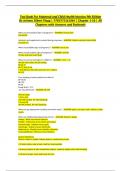Exam (elaborations)
Maternal and Child Health Nursing 9th Edition By JoAnne Silbert Flagg | 9781975161064 | Chapter 1-56 | All Chapters with Answers and Rationals
- Course
- Institution
- Book
Maternal and Child Health Nursing 9th Edition By JoAnne Silbert Flagg | 9781975161064 | Chapter 1-56 | All Chapters with Answers and Rationals
[Show more]



